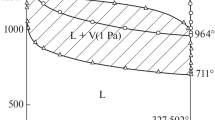Abstract
We analyze physicochemical processes of interaction between uranium, zirconium, and its alloy (with 1% Nb) with water vapor at temperatures up to 1500°K and study mechanisms and kinetics of these processes. It is shown that, up to 700°K, the kinetics of the process of oxidation of uranium is described by a linear function of time; at temperatures higher than 900°K, this dependence becomes parabolic. Our interpretation of the mechanism of the process of oxidation of uranium takes into account the influence of structural defects and electrochemical properties of uranium oxides formed in the course of this process. The process of oxidation of zirconium and its alloy with 1% Nb by water vapor obeys a cubic law in the temperature range 900–1200°K and a parabolic law in the range 1300–1500°K. The comparative analysis demonstrates that the hydrogen release rate in the process of uranium oxidation is about twice as high as in the process of vapor-zirconium reaction.
Similar content being viewed by others
References
V. G. Vlasov,Oxygen Compounds of Uranium [in Russian], Metallurgiya, Moscow (1972).
G. L. Miller,Zirconium, Butterworths Scientific Publications, London (1954).
M. A. Fomishkin, V. Yu. Tonkov, Yu. N. Dolgov, et al., “Investigation of the diffusion of oxygen in Zr-1% Nb alloy in the course of high-temperature oxidation in water vapor,”Atom. Energ.,65, No. 5, 321–326 (1988).
V. I. Solyanyi, Yu. K. Babilashvili, V. V. Dranenko, et al., “Analysis of the corrosion behavior of cans of fuel elements made of Zr-1% Nb alloy in water vapor at high temperatures,”VANT. Ser., Atom. Materialoved., Issue 2 (77), 89–95 (1988).
V. Vrtilkova, L. Molin, and K. Klots, “Kinetics of oxidation of cans made of Zr-1% Nb alloy in an atmosphere of water vapor in the temperature range 600–1200°C,”VANT. Ser., Atom. Materialoved., Issue 2 (77), 84–89 (1988).
V. A. Buchilin, “Experimental investigation of the behavior of cans of fuel elements of water-moderated water-cooled power reactors under conditions simulating emergency situations,”VANT, Atom. Materialoved., Issue 2 (27), 100–107 (1988).
Additional information
Karpenko Physicomechanical Institute, Ukrainian Academy of Sciences, L'viv. Translated from Fiziko-Khimicheskaya Mekhanika Materialov, Vol. 31, No. 3, pp. 36–43, May–June 1995.
Rights and permissions
About this article
Cite this article
Polyakov, V.N., Gnyp, I.P., Gedkovd, K.N. et al. High-temperature interaction of uranium and zirconium with water vapor. Mater Sci 31, 316–323 (1996). https://doi.org/10.1007/BF00558553
Received:
Issue Date:
DOI: https://doi.org/10.1007/BF00558553



